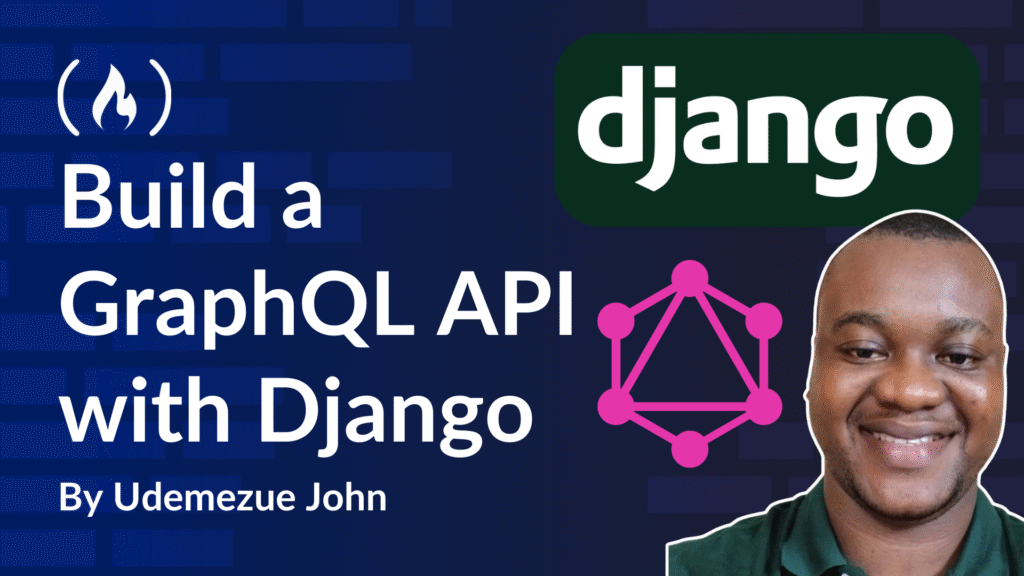If you’re building an app with Django and thinking about using GraphQL, you’re not alone.
REST has been the go-to for years, but GraphQL is quickly becoming a favourite option for developers who want more flexibility and less back-and-forth between frontend and backend.
I’ve spent a lot of time working with Django and playing around with different ways to make APIS smoother, and I get why people are switching to GraphQL.
You ask for exactly the data you need, and you get just that. No extra fluff, no multiple requests to stitch together data — it’s like ordering off a menu and getting exactly what you wanted, every single time.
So, if you’re curious about how to build a GraphQL API using Django, I’ve got you covered.
I’ll walk you through what GraphQL is, why it might be a better fit than REST in some cases, and how you can get started from scratch — even if you’re not a GraphQL expert (yet).
Here’s what we’ll cover:
What Is GraphQL, and Why Does It Matter?
GraphQL is a query language for APIs — and more importantly, it’s a runtime for fulfilling those queries with your data.
It was developed by Facebook in 2012 and made public in 2015. Since then, it’s been used by companies like GitHub, Shopify, Twitter, and Pinterest.
Unlike REST, where you often have to make multiple requests to get all the data you need, GraphQL lets you fetch all your data in a single request.
This is a big deal, especially for mobile apps or slow networks where fewer requests mean better performance.
Let’s say you want a user’s name, profile picture, and their 3 most recent blog posts. With REST, you might need to hit 2-3 different endpoints. With GraphQL? One request, done.
It’s also great for frontend devs because they can shape the data they get back without waiting for backend devs to create new endpoints.
What You’ll Need Before You Start
Before jumping in, here’s what you should already have:
Basic knowledge of Django (models, views, and so on)
Python installed (3.8+ is best)
A Django project set up
pip or pipenv for package management
If you’re starting fresh, you can spin up a new Django project with:
django-admin startproject myproject
<span class="hljs-built_in">cd</span> myproject
python manage.py startapp myapp
How to Build a GraphQL API in Django
Let’s get into it.
1. Install Graphene-Django
Graphene is the most popular library for using GraphQL with Python. For Django specifically, there’s a package called graphene-django.
You can install it like this:
pip install graphene-django
Then, add it to your INSTALLED_APPS:
INSTALLED_APPS = [
...
<span class="hljs-string">'graphene_django'</span>,
]
2. Add a Simple Model
Here’s a quick model to work with. In myapp/models.py:
<span class="hljs-keyword">from</span> django.db <span class="hljs-keyword">import</span> models
<span class="hljs-class"><span class="hljs-keyword">class</span> <span class="hljs-title">Post</span>(<span class="hljs-params">models.Model</span>):</span>
title = models.CharField(max_length=<span class="hljs-number">100</span>)
content = models.TextField()
published = models.DateTimeField(auto_now_add=<span class="hljs-literal">True</span>)
<span class="hljs-function"><span class="hljs-keyword">def</span> <span class="hljs-title">__str__</span>(<span class="hljs-params">self</span>):</span>
<span class="hljs-keyword">return</span> self.title
Then run your migrations:
python manage.py makemigrations
python manage.py migrate
3. Create a Schema
In myapp/schema.py, start with:
<span class="hljs-keyword">import</span> graphene
<span class="hljs-keyword">from</span> graphene_django.types <span class="hljs-keyword">import</span> DjangoObjectType
<span class="hljs-keyword">from</span> .models <span class="hljs-keyword">import</span> Post
<span class="hljs-class"><span class="hljs-keyword">class</span> <span class="hljs-title">PostType</span>(<span class="hljs-params">DjangoObjectType</span>):</span>
<span class="hljs-class"><span class="hljs-keyword">class</span> <span class="hljs-title">Meta</span>:</span>
model = Post
<span class="hljs-class"><span class="hljs-keyword">class</span> <span class="hljs-title">Query</span>(<span class="hljs-params">graphene.ObjectType</span>):</span>
all_posts = graphene.List(PostType)
<span class="hljs-function"><span class="hljs-keyword">def</span> <span class="hljs-title">resolve_all_posts</span>(<span class="hljs-params">root, info</span>):</span>
<span class="hljs-keyword">return</span> Post.objects.all()
schema = graphene.Schema(query=Query)
Then, in your Django project settings, add:
GRAPHENE = {
<span class="hljs-string">"SCHEMA"</span>: <span class="hljs-string">"myapp.schema.schema"</span>
}
And finally, in your urls.py:
<span class="hljs-keyword">from</span> django.urls <span class="hljs-keyword">import</span> path
<span class="hljs-keyword">from</span> graphene_django.views <span class="hljs-keyword">import</span> GraphQLView
<span class="hljs-keyword">from</span> django.views.decorators.csrf <span class="hljs-keyword">import</span> csrf_exempt
urlpatterns = [
path(<span class="hljs-string">"graphql"</span>, csrf_exempt(GraphQLView.as_view(graphiql=<span class="hljs-literal">True</span>))),
]
Now, visit http://localhost:8000/graphql and try this query:
{
allPosts {
title
content
published
}
}
Boom. You just queried your database using GraphQL.
Here is what your GraphQL playground should look like.

How to Add Mutations (Also Known As Writing Data)
GraphQL isn’t just for reading data. You can also create, update, and delete. Here’s how to add a mutation for creating a post:
In myapp/schema.py:
<span class="hljs-class"><span class="hljs-keyword">class</span> <span class="hljs-title">CreatePost</span>(<span class="hljs-params">graphene.Mutation</span>):</span>
<span class="hljs-class"><span class="hljs-keyword">class</span> <span class="hljs-title">Arguments</span>:</span>
title = graphene.String(required=<span class="hljs-literal">True</span>)
content = graphene.String(required=<span class="hljs-literal">True</span>)
post = graphene.Field(PostType)
<span class="hljs-function"><span class="hljs-keyword">def</span> <span class="hljs-title">mutate</span>(<span class="hljs-params">self, info, title, content</span>):</span>
post = Post(title=title, content=content)
post.save()
<span class="hljs-keyword">return</span> CreatePost(post=post)
<span class="hljs-class"><span class="hljs-keyword">class</span> <span class="hljs-title">Mutation</span>(<span class="hljs-params">graphene.ObjectType</span>):</span>
create_post = CreatePost.Field()
schema = graphene.Schema(query=Query, mutation=Mutation)
Now, in the GraphiQL playground, you can run:
<span class="hljs-keyword">mutation</span> {
createPost(<span class="hljs-symbol">title:</span> <span class="hljs-string">"My First Post"</span>, <span class="hljs-symbol">content:</span> <span class="hljs-string">"Hello GraphQL!"</span>) {
post {
id
title
}
}
}
Pretty clean, right?
Code Walkthrough: Creating a Post via Mutation in GraphQL
Let me walk you through the code, explain what it does, and how GraphQL makes it work.
Step 1: The CreatePost Mutation Class
<span class="hljs-class"><span class="hljs-keyword">class</span> <span class="hljs-title">CreatePost</span>(<span class="hljs-params">graphene.Mutation</span>):</span>
<span class="hljs-class"><span class="hljs-keyword">class</span> <span class="hljs-title">Arguments</span>:</span>
title = graphene.String(required=<span class="hljs-literal">True</span>)
content = graphene.String(required=<span class="hljs-literal">True</span>)
post = graphene.Field(PostType)
<span class="hljs-function"><span class="hljs-keyword">def</span> <span class="hljs-title">mutate</span>(<span class="hljs-params">self, info, title, content</span>):</span>
post = Post(title=title, content=content)
post.save()
<span class="hljs-keyword">return</span> CreatePost(post=post)
Here’s what’s going on in this part:
graphene.Mutation: This defines a custom mutation, which in GraphQL is how we modify server-side data (similar to POST, PUT, and DELETE in REST).class Arguments: Think of this as the “input” part of the mutation. We’re requiring atitleandcontent, both as strings. These are what the client must provide when calling the mutation.post = graphene.Field(PostType): This defines the return type of the mutation. In this case, once a post is created, we return it using a custom GraphQL type calledPostType.mutate(self, info, title, content): This method is called when the mutation is executed. Inside it:We create a new
Postmodel instance.We save it to the database.
We return the mutation result as an
CreatePostobject with the new post attached.
This keeps the logic tight, readable, and testable – a great example of clean API design.
Step 2: Wiring the Mutation into the Schema
<span class="hljs-class"><span class="hljs-keyword">class</span> <span class="hljs-title">Mutation</span>(<span class="hljs-params">graphene.ObjectType</span>):</span>
create_post = CreatePost.Field()
This is where we register our mutation. In GraphQL, all operations (queries and mutations) must be part of the schema. By adding create_post to the Mutation class, we expose it to the GraphQL endpoint.
Step 3: The Final Schema
schema = graphene.Schema(query=Query, mutation=Mutation)
In this code,
We’re creating a new
graphene.Schema.We pass in a
Queryclass (assumed to be defined elsewhere for read operations) and ourMutationclass for write operations.
This is the GraphQL equivalent of wiring up Django’s urls.py – it’s what gets exposed to clients when they hit your /graphql/ endpoint.
How a Client Would Use This
A client (frontend or API testing tool like Insomnia/Postman) would send a mutation like this:
mutation {
createPost(title: <span class="hljs-string">"GraphQL is Awesome"</span>, content: <span class="hljs-string">"Let's build APIs with it!"</span>) {
post {
id
title
content
}
}
}
And get a response like:
{
<span class="hljs-string">"data"</span>: {
<span class="hljs-string">"createPost"</span>: {
<span class="hljs-string">"post"</span>: {
<span class="hljs-string">"id"</span>: <span class="hljs-string">"1"</span>,
<span class="hljs-string">"title"</span>: <span class="hljs-string">"GraphQL is Awesome"</span>,
<span class="hljs-string">"content"</span>: <span class="hljs-string">"Let's build APIs with it!"</span>
}
}
}
}
Bonus: Why This Is Awesome for Developers
Frontend teams can now build forms and instantly see the structure of the response.
Backend devs define what’s allowed and handle only necessary logic.
No more over-fetching or under-fetching data — GraphQL gives you just what you ask for.
Easy to test, debug, and scale.
Make Sure You Have the Following in Place
Ensure you have
graphene-djangoinstalled.Add
'graphene_django'to yourINSTALLED_APPS.Wire up the schema in your Django project’s
urls.py.
<span class="hljs-keyword">from</span> django.urls <span class="hljs-keyword">import</span> path
<span class="hljs-keyword">from</span> graphene_django.views <span class="hljs-keyword">import</span> GraphQLView
<span class="hljs-keyword">from</span> myapp.schema <span class="hljs-keyword">import</span> schema
urlpatterns = [
path(<span class="hljs-string">"graphql/"</span>, GraphQLView.as_view(graphiql=<span class="hljs-literal">True</span>, schema=schema)),
]
Pros and Cons of Using GraphQL in Django
Pros:
Flexible queries
Great for frontend devs
Fewer API calls
Strongly typed schema
Better performance on slower networks
Cons:
Slightly steeper learning curve
More setup than REST
Can be overkill for simple APIS
FAQs
Is GraphQL better than REST?
It depends. GraphQL gives you more control and flexibility, but REST is easier to cache and simpler to set up for small projects.
Is Graphene the only way to use GraphQL with Django?
Nope. You can also use Ariadne or Strawberry. But Graphene is the most mature and widely used right now.
Does GraphQL work well with Django REST Framework?
They can live side-by-side. If you already have a REST API and want to add GraphQL, you don’t need to throw anything away.
What’s Next?
Once you’ve got the basics down, you can:
Add authentication with JWT or sessions
Use Relay if you need pagination and filtering
Connect your GraphQL API to React, Vue, or any frontend
Final Thoughts
If you’ve been using Django for a while and want to give your API a little more power and flexibility, GraphQL is 100% worth checking out.
Further Resources
Source: freeCodeCamp Programming Tutorials: Python, JavaScript, Git & MoreÂ


